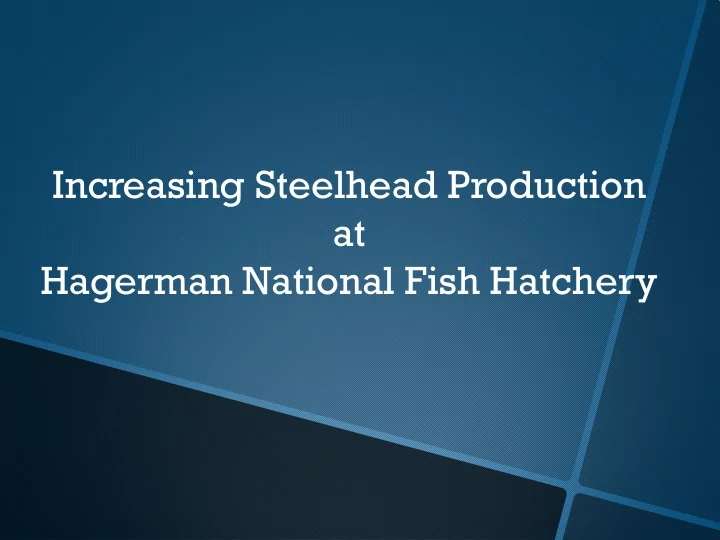

Increasing Steelhead Production at Hagerman National Fish Hatchery
Hagerman National Fish Hatchery Production The original smolt production was set at 1.7 million steelhead smolts annually. Reduction in spring flows in the Hagerman Valley since the program was initiated, limited smolt production to 1.36 million smolts. Recent efforts to increase water quality using nitrogen degassing and oxygen supplementation increased to 1.46 million yearling smolts. In addition HNFH will be constructing a reuse aquaculture system in 2014 that will initially produce an additional 90,000 smolts increasing production to 1.55 million steelhead smolts.
Reuse Aquaculture System (RAS ) at Hagerman National Fish Hatchery WHY? 1. A diminishing aquifer volume to meet production goals with current system. 2. A way to increase fish production with less water.
Typical Components of a Partial Reuse System
Split effluent flows: RAS system is designed to produce two or three outflow streams instead of one.
Claims in literature made using RAS: • Significant reductions in water flow required to produce fish. • Improved effluent water quality through the rapid removal of solids. • Fish exercise more due to higher water speeds in RAS resulting in higher smolt-to-adult survival (SAR). • Reduction in labor attributed to the self-cleaning nature of RAS. • More effective treatment of supply water quality problems, including pathogens and temperature, resulting from lower input flows associated with RAS.
Compare RAS to current Raceway System at Hagerman National Evaluation Metrics: Juvenile Fish Variables. • Growth rate—Changes in length and weight from ponding to release. • Condition factor—Calculated from growth measurements • Health/disease measures— reuse compared to raceway • Survival rate—Proportional survival from ponding to release. • Percent lipid/protein at release—Use proximate tissue analysis • Density and flow indices at release • Precocity at release • Fin condition at release • Smolt travel times (harmonic mean, median, cumulative curves) to Lower Granite and Bonneville dams • Smolt survival to Lower Granite and Bonneville dams
Adult Fish Variables • Smolt to adult survival (SAR) • Gender ratio • Age class structure • Homing/straying rates Environmental variables Water quality • Total nitrogen • Total phosphorus • pH • Temperature Water quantity • Pounds of fish reared per gallon (kg per m3).
Work elements RAS vs. Raceway • Feeding • Cleaning • Sampling • Treating • Crowding • Moving/releasing fish Cost effectiveness RAS vs. Raceway Feed conversion—calculated from growth measurements Energy use • Heating • Cooling • Pumping Man power savings Water savings (if a cost variable other than pumping costs) Other costs
Once the Hagerman NFH Reuse Aquaculture System is completed, data collection shown on the previous slides will commence. In a few years we should begin to realize if RAS can be a tool used to increase smolt production.
Questions or Comments
Recommend
More recommend